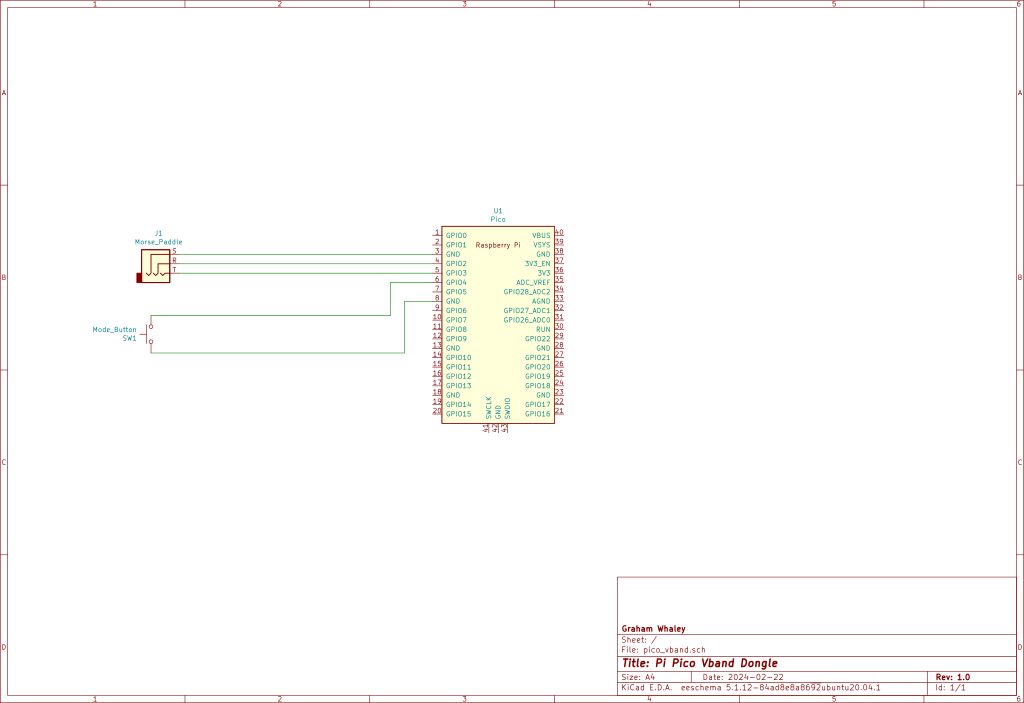This repository contains the code and instructions to build a USB dongle that allows a morse key or paddle to be conected to your computer like a USB keyboard, which then allows you to interact with web sites such as vband, Vail and morsecode.me.
I have a regular practice HF CW QSO with a friend of mine, but he lives about 35 miles away, the other side of a range of hills. This means quite often, conditions depending, we cannot get the HF NVIS to play ball, and thus cannot make an on air QSO.
Thus, at times we may wish to revert to an 'online' QSO. There are a few websites that enable that, such as:
You can 'send' on those sites using your keyboard, but it's much nicer to be able to use your morse key or paddle. To do this you require a 'dongle' that translates from your key into a USB HID device - aka, looks like a keyboard.
There are a number of projects that already exist to do this, ranging from the very simple using Aruduino-like micro controllers with anything from an Attiny to a SAMD21 processor. Here are some samples I took inspiration from:
I wanted to use a Pi Pico, as I had a number laying around doing nothing, and they are very very cheap. I also wanted to code this up in Arduino IDE C, as that is a common development environment, and I'm not really a Python guy (another common development system for the Pi Pico). If you want to go with a Python implementation, there are some details on KG5QNO's QRZ page.
The dongle implements a number of features:
- Supports single (straight) and dual (paddle) inputs
- Supports various key output modes to be compatible with multiple sites
- Mode changes through a single push button
- Activity feedback via an LED
Pretty much, plug your key or paddle into the dongle, plug your dongle into your computer, go to the web site you wish to use, and see if it recognises the keystrokes. If the site does not recognise the keystrokes you may need to press the 'mode' button to move to a mode that matches the site. The following tables show which mode generates which keystrokes.
| Mode | Keys | Notes |
|---|---|---|
| 1 | '[' ']' | Primarily vband, also Vail |
| 2 | 'x' 'z' | Vail |
| 3 | 'e' 'i' | morsecode.me |
| 4 | 'CTRL-L' 'CTRL-R' | vband and Vail |
It should be noted that mode 4 may be particularly useful, as the 'CTRL' keys may be detected by some websites even when the window does not have 'focus'.
For precise details on which site supports which input characters, please refer to the specific websites.
The mode key has the following functions:
| Action | Result |
|---|---|
| Short press(es) | Cycles through the modes. New mode number flashed out on LED |
| Long press | Reset to mode 1 |
The LED has a few functions:
- At boot it shows a 'heartbeat' until any key or button is pressed
- It lights when either key/paddle is being pressed
- It flashes out the mode as a number of dots after a mode change
I built the code in Arduino IDE version 1.8.13. I used the arduino-pico Pi Pico board support package rather than the Arduino MBed package, as the USB HID support seemed easier to get to work.
Set the board to 'Raspberry Pi RP2040 Boards (3.7.2)/Raspberry Pi Pico'. Set the 'USB Stack' to 'Pico SDK'.
There are few couple of other library dependencies:
There is nothing particularly specific to the Pi Pico in the code. If you port to another board you will need to ensure it has hardware support for USB HID mode. The USB HID code is also the most likely to need modifying, which may be as simple as changing the header files that are pulled in.
The overall design is pretty simple. In the main loop, read the morse key/paddle inputs, and send the appropriate characters over the USB HID keyboard interface. Also read the mode button to see if we need to swap modes. Flash the LED when necessary. That is about it, but there are some subtleties:
Debouncing. This is probably the most subtle item. We debounce the morse inputs to try and not send a stream of up/down key presses when really we only want one. Most debounce algorithms use some sort of delay (be that a timer or a stream of reads) to assess when the input has settled down before registering the event. I didn't want to do that, as I wanted to register the morse press as fast as I could so as to remove any perceivable lag or delay. Thus, what we do to debounce is register the key up as soon as we see a state change, but then ignore all other changes for a set debounce period. Currently the debounce period is set to 10mS. That seems to be fairly standard-ish for how long it takes a button to settle. Given a fast morse code 'dit' may get down to about 30mS, the 10mS delay should not interfere with us registering strokes.
The other interesting tiny bit of code is the handling of the LED. Sadly the library I chose does not have 'one shot' functions, so once you kick off a flash for instance then it will continue until you cancel it. That's not always useful. Thus, I use the timer library to set a timer to cancel the LED event at some future calculated time. It's a bit awkward, but seems to work.
The schematic is not exactly difficult. You merely need to connect the connections for the morse key/paddle, the mode switch and an LED.
There are some features I might add in the future. I've added them to the ToDo file.

